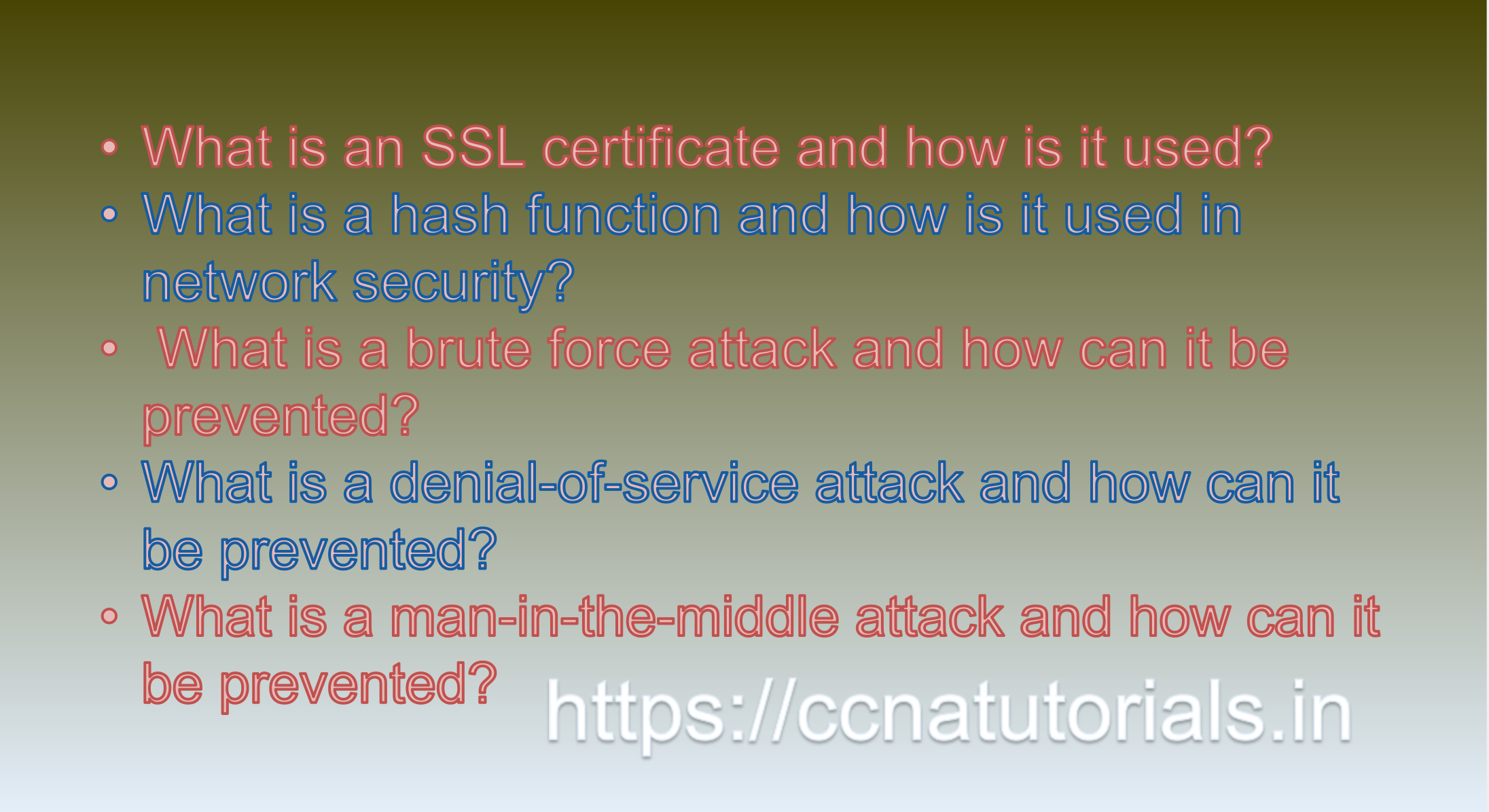Contents of this article
In this article, I describe some CCNA sample questions for practice before appearing in the CCNA 200-301 exam. The following questions are basic questions and related to the CCNA sample questions set 8. There are multiple sample questions set on this website for prior practice online. All questions are described with relevant answers. You can take the following questions and answer as reference for CCNA 200-301 exam. You may also need to do more practice with other websites and books to practice the CCNA sample questions set 8.
Question 1: What is an SSL certificate and how is it used?
An SSL (Secure Sockets Layer) certificate is a digital certificate that verifies the identity of a website and provides encryption for data transmitted between the website and the user’s web browser. It is used to ensure that sensitive information such as login credentials, credit card details, and personal information are transmitted securely over the internet.
SSL certificates are issued by a trusted third-party certificate authority (CA) and contain information about the website’s identity, such as its domain name and public key. When a user visits a website with an SSL certificate, their web browser will verify the certificate’s authenticity and establish a secure connection with the website.
The SSL certificate provides several benefits:
Encryption: The SSL certificate provides encryption for all data transmitted between the website and the user’s web browser, ensuring that it cannot be intercepted or read by third parties.
Authentication: The SSL certificate verifies the identity of the website, ensuring that users are communicating with the intended website and not an imposter.
Trust: The SSL certificate is issued by a trusted third-party certificate authority, providing users with confidence that they are communicating with a legitimate website.
There are several types of SSL certificates, including domain-validated (DV), organization-validated (OV), and extended validation (EV) certificates. Each type of certificate offers a different level of validation and security.
An SSL certificate is a digital certificate that verifies the identity of a website and provides encryption for data transmitted between the website and the user’s web browser. It provides encryption, authentication, and trust, ensuring that sensitive information is transmitted securely over the internet. This is the answer to question 1 of CCNA sample questions set 8.
Question 2: What is a hash function and how is it used in network security?
A hash function is a mathematical function that takes input data of any size and produces a fixed-size output, known as a hash. The hash is a unique and compact digital fingerprint of the input data, which is used for a variety of purposes in network security.
One common use of hash functions in network security is for data integrity verification. By generating a hash of a file or message before transmitting it over a network, the receiver can independently generate a hash of the received data and compare it with the original hash to ensure that the data has not been modified or tampered with during transmission. If the hashes match, it provides strong evidence that the data has not been altered.
Another use of hash functions in network security is for password storage. Rather than storing passwords in plain text, which can be easily stolen or compromised, a hash of the password is stored instead. When a user enters their password, the hash is generated and compared with the stored hash. If the hashes match, the user is authenticated.
Hash functions are also used in digital signatures, which are used to ensure the authenticity and integrity of electronic documents. By generating a hash of a document and encrypting it with a private key, the document can be signed and verified by anyone with the corresponding public key.
A hash function is a mathematical function that generates a unique and compact digital fingerprint of input data. Hash functions are used in network security for data integrity verification, password storage, and digital signatures. This is the answer to question 2 of CCNA sample questions set 8.
Question 3: What is a brute force attack and how can it be prevented?
A brute force attack is a type of cyber attack in which an attacker attempts to gain unauthorized access to a system or account by trying many possible passwords or encryption keys until the correct one is found. This attack relies on the attacker systematically trying every possible combination of characters until the correct password or key is discovered.
There are several ways to prevent a brute force attack:
Strong passwords: The use of strong, complex passwords that are difficult to guess can make it harder for attackers to successfully perform a brute force attack.
Account lockouts: Implementing account lockout policies can limit the number of failed login attempts before an account is locked, preventing further attempts by an attacker.
Rate limiting: Rate limiting can limit the number of login attempts that can be made from a particular IP address or network over a specified time period, which can help prevent a brute force attack.
Two-factor authentication: Using two-factor authentication can provide an additional layer of security, requiring an attacker to have more than just a password to gain access.
Captcha: Implementing captcha on login pages can prevent automated scripts from performing brute force attacks.
Intrusion detection and prevention systems (IDPS): IDPS can detect and prevent brute force attacks by monitoring network traffic and flagging suspicious activity.
In summary, a brute force attack is a type of cyber attack in which an attacker systematically tries every possible combination of characters to guess a password or encryption key. To prevent a brute force attack, strong passwords, account lockouts, rate limiting, two-factor authentication, captcha, and IDPS can be implemented. This is the answer to question 3 of CCNA sample questions set 8.

Question 4: What is a denial-of-service attack and how can it be prevented?
A denial-of-service (DoS) attack is a type of cyber attack that aims to disrupt the normal functioning of a system, network, or website by overwhelming it with a flood of traffic or requests. The goal of a DoS attack is to make the targeted system unavailable to its intended users.
There are several ways to prevent a DoS attack:
DDoS Protection: Distributed denial-of-service (DDoS) protection solutions use various techniques, such as rate limiting, traffic filtering, and behavioral analysis to detect and block malicious traffic.
Firewall Protection: Firewalls can block traffic from known malicious IP addresses or limit the number of requests that can be sent to a system or application.
Load Balancing: Load balancing can distribute traffic evenly across multiple servers, preventing a single server from being overwhelmed by a flood of requests.
Intrusion Detection and Prevention Systems (IDPS): IDPS can detect and block malicious traffic, such as flooding or port scanning, and prevent it from reaching its target.
DNS Protection: DNS protection services can help prevent DoS attacks that exploit vulnerabilities in the Domain Name System (DNS) infrastructure.
Cloud-based Services: Cloud-based services can help absorb and mitigate the impact of DoS attacks by providing additional resources and infrastructure to handle the traffic.
Best Practices: Best practices, such as keeping software and systems up to date, using strong passwords, and implementing multi-factor authentication, can also help prevent DoS attacks.
In summary, a denial-of-service (DoS) attack is a type of cyber attack that aims to disrupt the normal functioning of a system, network, or website. To prevent a DoS attack, DDoS protection, firewall protection, load balancing, IDPS, DNS protection, cloud-based services, and best practices can be implemented. This is the answer to question 4 of CCNA sample questions set 8.
Question 5 : What is a man-in-the-middle attack and how can it be prevented?
A man-in-the-middle (MITM) attack is a type of cyber attack where an attacker intercepts communication between two parties and can eavesdrop or modify the communication. In this type of attack, the attacker can intercept and steal sensitive information, such as login credentials, financial information, or personal data.
There are several ways to prevent a man-in-the-middle attack:
Use Encryption: Encryption is the process of encoding information so that it can only be read by authorized parties. By using encryption, even if an attacker intercepts the communication, they will not be able to read or modify the information. HTTPS, SSL/TLS, and VPNs are examples of encryption technologies that can help prevent MITM attacks.
Use Strong Authentication: Strong authentication, such as multi-factor authentication, can help prevent unauthorized access to sensitive information. By requiring multiple forms of authentication, it becomes more difficult for an attacker to impersonate a legitimate user.
Implement Certificate Pinning: Certificate pinning is a technique where a client application only trusts a specific certificate or set of certificates. By implementing certificate pinning, it becomes more difficult for an attacker to use a fraudulent or compromised certificate.
Use Public Key Infrastructure (PKI): PKI is a system of digital certificates, Certificate Authorities (CAs), and other registration authorities that verify and authenticate the validity of each party involved in an online transaction. By using PKI, it becomes more difficult for an attacker to impersonate a legitimate user or device.
Use Network Segmentation: Network segmentation is the process of dividing a network into smaller, isolated subnetworks. By segmenting the network, an attacker who gains access to one segment of the network will not be able to access other segments.
Implement Best Practices: Best practices, such as keeping software and systems up to date, using strong passwords, and implementing access controls, can also help prevent MITM attacks.
A man-in-the-middle (MITM) attack is a type of cyber attack where an attacker intercepts communication between two parties and can eavesdrop or modify the communication. To prevent a MITM attack, encryption, strong authentication, certificate pinning, PKI, network segmentation, and best practices can be implemented. This is the answer to question 5 of CCNA sample questions set 8.
Conclusion for CCNA sample questions set 8
In this article, I described 5 questions with answers related to CCNA 200-301 exam. I hope you found these questions helpful for the practice of the CCNA 200-301 exam. You may drop a comment below or contact us for any queries related to the above questions and answers for CCNA 200-301. Share the above questions If you found them useful. Happy reading!!






